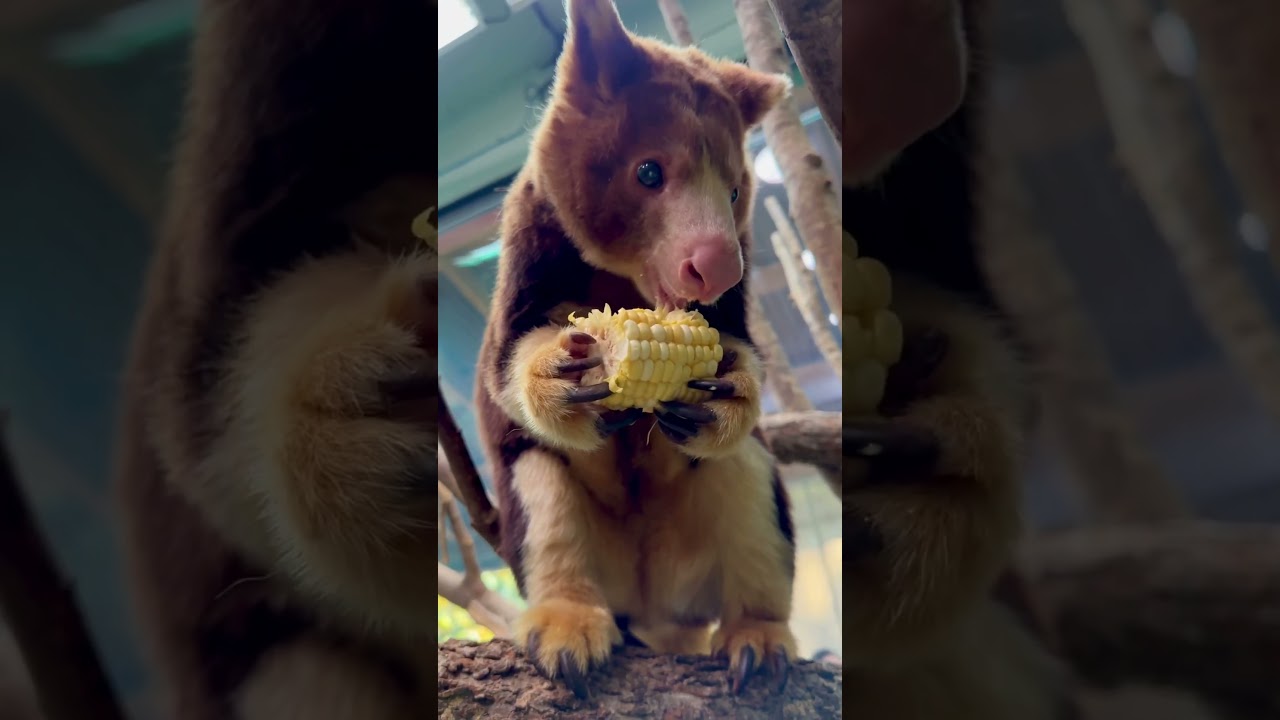– Discovering the endearing eating habits of Libby, the tree kangaroo who adores corn.
– Understanding the nutritional requirements and food preferences of tree kangaroos in captivity.
– Exploring how zoos contribute to the conservation and knowledge of lesser-known species like tree kangaroos.
There’s something undeniably captivating about observing the everyday antics of animals, whether in the wild or under the attentive care of a sanctuary or zoo. Their behaviors, tastes, and the little quirks they develop can be as unique and individual as our own. Today, we embark on a delightful journey to glimpse into the life of one such special resident of the animal kingdom: Libby, the tree kangaroo with an insatiable appetite for corn.
Picture, if you will, a lush enclosure modeled after the dense, verdant rainforests of Australia and New Guinea, complete with towering trees and a multitude of climbing structures. It’s in this verdant habitat that Libby spends her days. She’s agile, arboreal, and adorable. But Libby isn’t your run-of-the-mill macropod—she’s a tree kangaroo. This incredible marsupial defies the hopping image we typically associate with kangaroos by gracefully maneuvering through the trees.
Libby’s partiality towards corn is an intriguing twist to her fascinating life. Corn is not a natural part of a tree kangaroo’s diet; their menus mostly consist of leaves, fruit, and flowers in the wild. However, life in captivity offers various food options, including healthy treats, to help maintain the animals’ health and well-being. Corn, as it turns out, can serve as a source of nutrition and entertainment for Libby.
The appeal of corn for Libby could be manifold. On a nutritional level, corn offers carbohydrates and a modest amount of protein and fiber. However, it’s imperative to be mindful of portion sizes and the overall balance of nutrients in her diet. A surplus of corn could disrupt this balance, leading to weight gain or other health complications. Animal caretakers at the zoo are keenly aware of these requirements and provide Libby with a diet meticulously calibrated to mirror natural nutritional values as closely as possible.
It’s worth considering why a tree kangaroo would develop such a taste for corn. One theory suggests that the texture and taste of the kernels provide a novel sensory experience that Libby finds appealing. Eating corn, especially on the cob, also involves interesting manual dexterity, challenging her in ways similar to manipulations she would encounter in the wild when foraging or navigating through the dense foliage.
Yet the story of Libby and her corn goes beyond mere dietary preferences; it serves as a gentle reminder of the preciousness of biodiversity and the singular habits that define each species. Tree kangaroos such as Libby are a testament to nature’s wonders. Unfortunately, they also remind us of vulnerability as they face threats like habitat destruction and hunting in their natural habitat. Finding joy in Libby’s love for corn should inspire amusement and a deeper respect and urgency toward conserving these unique creatures.
Zoos often serve as arks for endangered species, offering safe havens for breeding and research programs that are fundamental in bringing animals back from the brink of extinction. Each animal cared for by zoos, along with its distinctive behaviors and preferences, is an ambassador for its wild counterparts. Zoos grant us the incredible privilege of intimately understanding species’ needs, from digestive health to psychological wellness, which can be applied to global conservation efforts.
Libby’s care team at the zoo exemplifies this dedication. They don’t just provide her with the corn she’s so fond of; they observe, take notes, and adapt. They’re always learning from her about what it means for a tree kangaroo to survive and thrive. Through their diligent work, they ensure that each meal, each enrichment activity, and every interaction is a step towards a fuller life for Libby.
The world of zookeeping is one of constant discovery and never-ending curiosity. It’s where the simple sight of Libby savoring a cob of corn can unravel into a rich tapestry of nutritional science, conservation efforts, and behavioral enrichment. It’s a profession grounded in the nuanced blend of caretaking and scientific research, where the health and happiness of every inhabitant marries the broader goals of species preservation and environmental education.
Fostering an appreciation for animals like Libby is fundamental to the mission of zoos and wildlife sanctuaries. The connection visitors form with these creatures during their visits can ignite a passion for conservation that lasts a lifetime. Whether it’s in awe of her arboreal agility or the humorous enthusiasm with which she devours her favorite treat, each moment spent with Libby is an opportunity to inspire.
As we close this exploration into Libby’s world, it is important to remember that her love for corn, while charming and endearing, is merely one facet of the vital role that modern zoological institutions play. They are not only homes for animals like Libby but also centers of education, research, and conservation, contributing to a future where the diversity of life continues to flourish for generations to come.
Libby’s story is a powerful reminder of our responsibility and capacity to foster a harmonious coexistence with all the earth’s inhabitants. When we marvel at Libby’s quirky cravings, we celebrate the joy of animals and the deep-seated human desire to understand and protect the intricate web of life that supports us all. Whether swinging from branch to branch or nibbling on a cob of corn with unfettered delight, Libby represents a bridge between our worlds – built on care, respect, and an endless curiosity for the natural world.
*****
Source Description


